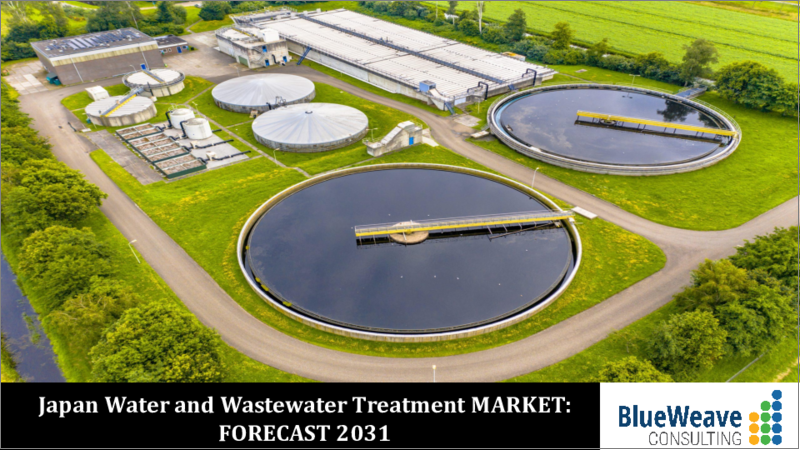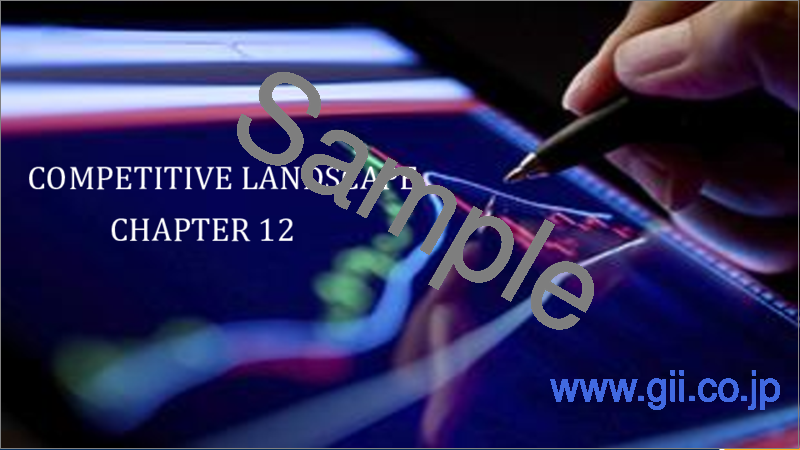|
|
市場調査レポート
商品コード
1534455
日本の上下水道処理市場:化学薬品タイプ別、水処理プロセス別、用途別、動向分析、競合情勢、予測、2019年-2030年Japan Water and Wastewater Treatment Market, By Chemical Type; By Water Treatment Process; By Application, Trend Analysis, Competitive Landscape & Forecast, 2019-2030 |
||||||
|
|||||||
| 日本の上下水道処理市場:化学薬品タイプ別、水処理プロセス別、用途別、動向分析、競合情勢、予測、2019年-2030年 |
|
出版日: 2024年07月15日
発行: Blueweave Consulting
ページ情報: 英文 200 Pages
納期: 2~3営業日
|
- 全表示
- 概要
- 図表
- 目次
日本の上下水道処理市場規模は2030年までに174億米ドルを突破する勢い
日本の上下水道処理市場は、急速な都市化、産業の発展、水不足懸念の高まり、水質汚染に対する意識の高まりなどを主な要因として活況を呈しています。
戦略コンサルティング・市場調査会社大手のブルーウィーブ・コンサルティング(BlueWeave Consulting)は最近の調査で、2023年の日本の上下水道処理市場規模を金額ベースで103億米ドルと推定しました。2024年から2030年にかけての予測期間中、日本の上下水道処理市場規模はCAGR 8%で拡大し、2030年には174億米ドルに達するとBlueWeaveは予測しています。日本の上下水道処理市場は、自治体内の上下水道処理薬品に対する需要の急増と、さまざまな部門にわたる工業生産の増加が後押ししています。特に紙・パルプ、食品加工、水処理などの業界では、厳しい規制の枠組みが、厳格な持続可能性基準を満たすよう設計された高度処理施設の設立を後押ししています。さらに、水不足に対する環境不安も、革新的な廃水処理技術の採用を早めています。その結果、pH調整剤や殺生物剤などの処理薬品への要求が顕著に上昇し、日本の上下水道処理市場の拡大に極めて重要な役割を果たしています。
機会- 水のリサイクルと再利用への注目の高まり
日本では水のリサイクルと再利用への関心が高まっており、上下水道処理市場の企業に大きな成長機会をもたらすと予想されます。1980年代以降、日本は主にトイレの洗浄や情勢の灌漑などの目的で、都市部での非飲料水の再利用を実施してきました。しかし、不十分な水質基準や再生施設での高いエネルギー消費といった課題により、より広範な導入は制限されてきました。CRESTプロジェクトのような取り組みに代表される最近の技術的進歩は、こうした障害を克服しようとする日本の決意を示しています。紫外線照射と組み合わせた限外ろ過のような技術は、低コストでウイルス除去に効果的であることが証明されており、農業用水の再利用を促進しています。2024年の能登半島地震のような自然災害時に導入されたWOTAの分散型水リサイクルシステムのようなイノベーションは、適応型水管理ソリューションにおける日本のリーダーシップを浮き彫りにしています。日本が水処理インフラと技術を強化し続ける中、技術革新と成長する取り組みは、当面の課題に対処するだけでなく、水分野における持続可能な成長の扉を開くものでもあります。その結果、日本の上下水道処理市場は予測期間中に大幅な成長が見込まれます。
凝集剤と凝集剤の化学タイプが市場を独占
日本の上下水道処理市場は、化学タイプ別に腐食防止剤、殺生物剤・殺菌剤、凝集剤・凝集沈殿剤、キレート剤、消泡剤、PH調整剤・安定剤、その他(スケール防止剤を含む)に区分されます。なかでも凝集剤・凝集剤は、水中の汚れ、細菌、汚染物質などの浮遊粒子の除去に重要な役割を果たし、日本の上下水道処理市場において化学物質タイプ別で最も高いシェアを占めています。凝集剤は、粒子を不安定化し凝集させることによって機能し、その抽出を簡素化する一方、凝集剤は、効率的に濾過または沈殿させることができる、より大きく高密度の粒子の形成を助ける。これらの化学薬品は、自治体、工業、廃水処理の各分野で幅広く使用されており、浄化された水に対する世界の需要の高まりに対応し、その普及を後押ししています。凝集剤と凝集剤技術の継続的な進歩は、市場の拡大をさらに推進すると予想されます。これらの技術革新は、浄水プロセスの有効性と効率を継続的に向上させ、水質基準の維持におけるこの分野の極めて重要な役割を強化しています。
地政学的緊張の高まりが日本の上下水道処理市場に与える影響
地政学的緊張の激化は日本の上下水道処理市場に多面的な影響を及ぼす可能性があります。各国間の紛争は処理部品のサプライチェーンを混乱させ、重要インフラに対するサイバーセキュリティ・リスクを増大させ、国際的な研究開発協力を妨げる可能性があります。貿易制限はまた、先端技術へのアクセスを制限する可能性があり、日本は国内生産を強化し、水処理自給自足達成に向けた研究を急ぐ必要に迫られます。国際関係に混乱が生じれば、重要な資源と専門知識の流れが妨げられ、市場の成長と近代化構想が遅れる可能性があります。さらに、水処理薬品の製造に不可欠な硫酸アルミニウムや鉱油といった必須原材料は、コスト上昇の中、日本がロシアのエネルギーに大きく依存していることから、価格上昇に見舞われる可能性があります。その結果、主要地域全体の地政学的緊張の高まりが日本の上下水道処理市場の成長に影響を及ぼす可能性があります。
競合情勢
日本の上下水道処理市場は非常に断片化されており、多数の企業が市場に参入しています。市場を独占している主な企業には、ヴェオリア、クボタ、オルガノ、フジクリーン、メタウォーター、新東工業、栗田工業、旭化学工業、東ケミ、日立造船などが含まれます。各社が採用した主なマーケティング戦略は、施設拡大、製品の多様化、提携、協力、パートナーシップ、買収などであり、日本の上下水道処理市場において顧客リーチを拡大し、競合他社に対する競争優位性を獲得しています。
本レポートの詳細な分析により、成長の可能性、今後の動向、日本の上下水道処理市場の統計に関する情報を提供します。また、総市場規模の予測を促進する要因も取り上げています。本レポートは、意思決定者が健全な戦略的意思決定を行うのに役立つ業界洞察とともに、日本の上下水道処理市場の最新技術動向を提供することをお約束します。さらに、市場の成長促進要因・課題・競争力についても分析しています。
目次
第1章 調査の枠組み
第2章 エグゼクティブサマリー
第3章 日本の上下水道処理市場の洞察
- 業界バリューチェーン分析
- DROC分析
- 成長促進要因
- 急速な都市化と産業の成長
- 水不足の懸念が高まる
- 水質汚染に関する意識の高まり
- 抑制要因
- 初期費用が高い
- 複雑な規制環境
- 老朽化したインフラとアップグレードの必要性
- 機会
- 水のリサイクルと再利用への注目が高まる
- 水処理技術の革新
- スマートな水管理ソリューションに対する需要が高まっています。
- 課題
- 水処理施設の効率的な運用と保守の確保
- 水管理および処理分野における熟練した専門家の不足。
- 成長促進要因
- 技術の進歩/最近の動向
- 規制の枠組み
- ポーターのファイブフォース分析
第4章 日本の上下水道処理市場:マーケティング戦略
第5章 日本の上下水道処理市場概要
- 市場規模と予測、2019-2030年
- 金額別
- 市場シェアと予測
- 化学物質の種類別
- 腐食防止剤
- 殺生物剤と消毒剤
- 凝固剤と凝集剤
- キレート剤
- 消泡剤
- PH調整剤と安定剤
- その他(スケール抑制剤を含む)
- 水処理プロセス別
- 下水処理プロセス
- 排水処理プロセス
- 活性汚泥法
- その他(消毒、逆浸透を含む)
- 用途別
- 民間用
- 産業用
- 化学物質の種類別
第6章 競合情勢
- 主要企業とその製品一覧
- 日本の上下水道処理企業の市場シェア分析、2023年
- 経営パラメータによる競合ベンチマーキング
- 主要な戦略開発(合併、買収、提携)
第7章 地政学的緊張が日本の上下水道処理市場に与える影響
第8章 企業プロファイル(会社概要、財務マトリックス、競合情勢、主要人物、主要競合、連絡先、戦略展望、 SWOT分析)
- Veolia
- KUBOTA Corporation
- Organo Corporation
- FujiClean Co., Ltd
- METAWATER. CO., LTD
- SINTOKOGIO, LTD
- Kurita Water Industries Ltd
- ASAHI CHEMICAL &INDUSTRIAL CO., LTD
- Tohkemy Corporation
- Hitachi Zosen Corporation
- その他の主要企業
第9章 主要な戦略的提言
第10章 調査手法
List of Figures
- Figure 1 Japan Water and Wastewater Treatment Segmentation
- Figure 2 Japan Water and Wastewater Treatment Market Value Chain Analysis
- Figure 3 Company Market Share Analysis, 2023
- Figure 4 Japan Water and Wastewater Treatment Market Size, By Value (USD Billion), 2019-2030
- Figure 5 Japan Water and Wastewater Treatment Market Share, By Chemical Type, By Value (USD Billion), 2019-2030
- Figure 6 Japan Water and Wastewater Treatment Market Share, By Water Treatment Process, By Value (USD Billion), 2019-2030
- Figure 7 Japan Water and Wastewater Treatment Market Share, By Application, By Value (USD Billion), 2019-2030
List of Tables
- Table 1 Japan Water and Wastewater Treatment Market Size, By Value (USD Billion), 2019-2030
- Table 2 Japan Water and Wastewater Treatment Market Share, By Chemical Type, By Value (USD Billion), 2019-2030
- Table 3 Japan Water and Wastewater Treatment Market Share, By Water Treatment Process, By Value (USD Billion), 2019-2030
- Table 4 Japan Water and Wastewater Treatment Market Share, By Application, By Value (USD Billion), 2019-2030
- Table 5 Veolia Company Overview
- Table 6 Veolia Financial Overview
- Table 7 KUBOTA Corporation Company Overview
- Table 8 KUBOTA Corporation Financial Overview
- Table 9 Organo Corporation Company Overview
- Table 10 Organo Corporation Financial Overview
- Table 11 FujiClean Co., Ltd Company Overview
- Table 12 FujiClean Co., Ltd Financial Overview
- Table 13 METAWATER. CO., LTD Company Overview
- Table 14 METAWATER. CO., LTD Financial Overview
- Table 15 SINTOKOGIO, LTD Company Overview
- Table 16 SINTOKOGIO, LTD Financial Overview
- Table 17 Kurita Water Industries Ltd Company Overview
- Table 18 Kurita Water Industries Ltd Financial Overview
- Table 19 ASAHI CHEMICAL & INDUSTRIAL CO., LTD Company Overview
- Table 20 ASAHI CHEMICAL & INDUSTRIAL CO., LTD Financial Overview
- Table 21 Tohkemy Corporation Company Overview
- Table 22 Tohkemy Corporation Financial Overview
- Table 23 Hitachi Zosen Corporation Company Overview
- Table 24 Hitachi Zosen Corporation Financial Overview
Japan Water and Wastewater Treatment Market Size Booming to Surpass USD 17.4 Billion by 2030
Japan Water and Wastewater Treatment Market is booming primarily due to rapid urbanization, industrial growth, escalating water scarcity concerns, and heightened awareness about water pollution.
BlueWeave Consulting, a leading strategic consulting and market research firm, in its recent study, estimated Japan Water and Wastewater Treatment Market size by value at USD 10.3 billion in 2023. During the forecast period between 2024 and 2030, BlueWeave expects Japan Water and Wastewater Treatment Market size to expand at a CAGR of 8% reaching a value of USD 17.4 billion by 2030. The Water and Wastewater Treatment Market in Japan is propelled the surging demand for water and wastewater treatment chemicals within municipal bodies and increased industrial production across various sectors. Stringent regulatory frameworks, particularly in industries like paper and pulp, food processing, and water processing, are driving the establishment of advanced treatment facilities designed to meet rigorous sustainability criteria. Environmental anxieties regarding water scarcity are additionally hastening the adoption of innovative wastewater treatment technologies. As a result, there is a notable uptick in the requirement for treatment chemicals such as pH control agents and biocides, playing a pivotal role in expanding Japan Water and Wastewater Treatment Market.
Opportunity - Increasing focus on water recycling and reuse
Japan's increasing focusing on water recycling and reuse is expected to present significant growth opportunities for the players in Water and Wastewater Treatment Market. Since the 1980s, Japan has implemented non-potable water reuse in urban areas, primarily for purposes such as toilet flushing and landscape irrigation. However, challenges such as inadequate quality standards and high energy consumption in reclamation facilities have limited broader adoption. Recent technological advancements, exemplified by initiatives like the CREST project, demonstrate Japan's commitment to overcoming these obstacles. Technologies like ultrafiltration combined with ultraviolet radiation have proven effective in virus removal at reduced costs, facilitating agricultural water reuse. Innovations, such as WOTA's decentralized water recycling systems, deployed during natural disasters like the 2024 Noto Peninsula Earthquake, highlight Japan's leadership in adaptive water management solutions. As Japan continues to enhance its water treatment infrastructure and technology, innovations and growing efforts not only address immediate challenges but also open doors for sustainable growth in the water sector. As a result, Japan Water and Wastewater Treatment Market is expected to grow at a significant rate over the forecast period.
Coagulants & Flocculants Chemical Type Dominates the Market
Japan Water and Wastewater Treatment Market, on the basis of chemical type, is segmented into Corrosion Inhibitors, Biocides & Disinfectants, Coagulants & Flocculants, Chelating Agents, Anti-Foaming Agents, PH Adjusters & Stabilizers, and Others (Including Scale Inhibitors). Among them, the coagulants & flocculants segment accounts for the highest share in Japan Water and Wastewater Treatment Market by chemical type, crucially facilitating the removal of suspended particles such as dirt, bacteria, and contaminants from water. Coagulants function by destabilizing and aggregating particles, simplifying their extraction, while flocculants aid in forming larger, denser particles that can be efficiently filtered or settled out. These chemicals find extensive application across municipal, industrial, and wastewater treatment sectors, meeting the escalating global demand for purified water and driving their widespread adoption. Ongoing advancements in coagulant and flocculant technologies are anticipated to further propel market expansion. These innovations continuously enhance the effectiveness and efficiency of water purification processes, reinforcing the segment's pivotal role in maintaining water quality standards.
Impact of Escalating Geopolitical Tensions on Japan Water and Wastewater Treatment Market
Intensifying geopolitical tensions can have a multifaceted impact on Japan Water and Wastewater Treatment Market. Conflicts among countries may disrupt supply chains for treatment components, increase cybersecurity risks to critical infrastructure, and hinder international research and development collaborations. Trade restrictions could also restrict access to advanced technologies, prompting Japan to bolster domestic production and expedite research towards achieving water treatment self-sufficiency. Any disruptions in international relations could impede the flow of critical resources and expertise, potentially delaying market growth and modernization initiatives. Additionally, essential materials such as aluminum sulfate and mineral oil, vital for manufacturing water treatment chemicals, may see price hikes given Japan's heavy reliance on Russian energy amidst escalating costs. Consequently, escalating geopolitical tensions across the major regions may affect the growth of Japan Water and Wastewater Treatment Market.
Competitive Landscape
Japan Water and Wastewater Treatment Market is highly fragmented, with numerous players serving the market. The key players dominating the market include Veolia, KUBOTA Corporation, Organo Corporation, FujiClean Co., Ltd, METAWATER CO., LTD, SINTOKOGIO, LTD, Kurita Water Industries Ltd, ASAHI CHEMICAL & INDUSTRIAL CO., LTD, Tohkemy Corporation, and Hitachi Zosen Corporation. The key marketing strategies adopted by the players are facility expansion, product diversification, alliances, collaborations, partnerships, and acquisitions to expand their customer reach and gain a competitive edge over their competitors in Japan Water and Wastewater Treatment Market.
The report's in-depth analysis provides information about growth potential, upcoming trends, and Japan Water and Wastewater Treatment Market statistics. It also highlights the factors driving forecasts of total market size. The report promises to provide recent technology trends in Japan Water and Wastewater Treatment Market along with industry insights to help decision-makers make sound strategic decisions. Furthermore, the report also analyses the growth drivers, challenges, and competitive dynamics of the market.
Table of Contents
1. Research Framework
- 1.1. Research Objective
- 1.2. Product Overview
- 1.3. Market Segmentation
2. Executive Summary
3. Japan Water and Wastewater Treatment Market Insights
- 3.1. Industry Value Chain Analysis
- 3.2. DROC Analysis
- 3.2.1. Growth Drivers
- 3.2.1.1. Rapid urbanization and industrial growth
- 3.2.1.2. Increasing water scarcity concerns
- 3.2.1.3. Increasing awareness about water pollution
- 3.2.2. Restraints
- 3.2.2.1. High initial costs
- 3.2.2.2. Complex regulatory environment
- 3.2.2.3. Aging infrastructure and the need for upgrades
- 3.2.3. Opportunities
- 3.2.3.1. Increasing focus on water recycling and reuse
- 3.2.3.2. Innovations in water treatment technologies
- 3.2.3.3. Growing demand for smart water management solutions.
- 3.2.4. Challenges
- 3.2.4.1. Ensuring the efficient operation and maintenance of water treatment facilities
- 3.2.4.2. Shortage of skilled professionals in water management and treatment sectors.
- 3.2.1. Growth Drivers
- 3.3. Technological Advancements/Recent Developments
- 3.4. Regulatory Framework
- 3.5. Porter's Five Forces Analysis
- 3.5.1. Bargaining Power of Suppliers
- 3.5.2. Bargaining Power of Buyers
- 3.5.3. Threat of New Entrants
- 3.5.4. Threat of Substitutes
- 3.5.5. Intensity of Rivalry
4. Japan Water and Wastewater Treatment Market: Marketing Strategies
5. Japan Water and Wastewater Treatment Market Overview
- 5.1. Market Size & Forecast, 2019-2030
- 5.1.1. By Value (USD Billion)
- 5.2. Market Share & Forecast
- 5.2.1. By Chemical Type
- 5.2.1.1. Corrosion Inhibitors
- 5.2.1.2. Biocides & Disinfectants
- 5.2.1.3. Coagulants & Flocculants
- 5.2.1.4. Chelating Agents
- 5.2.1.5. Anti-Foaming Agents
- 5.2.1.6. PH Adjusters & Stabilizers
- 5.2.1.7. Others (including Scale Inhibitors)
- 5.2.2. By Water Treatment Process
- 5.2.2.1. Sewage Treatment Process
- 5.2.2.2. Effluent Treatment Process
- 5.2.2.3. Activated Sludge Process
- 5.2.2.4. Other (including Disinfection, Reverse Osmosis)
- 5.2.3. By Application
- 5.2.3.1. Municipal
- 5.2.3.2. Industrial
- 5.2.1. By Chemical Type
6. Competitive Landscape
- 6.1. List of Key Players and Their Products
- 6.2. Japan Water and Wastewater Treatment Company Market Share Analysis, 2023
- 6.3. Competitive Benchmarking, By Operating Parameters
- 6.4. Key Strategic Development (Merger, Acquisition, Partnership)
7. Impact of Geopolitical Tensions on Japan Water and Wastewater Treatment Market
8. Company Profiles (Company Overview, Financial Matrix, Competitive landscape, Key Personnel, Key Competitors, Contact Address, and Strategic Outlook, and SWOT Analysis)
- 8.1. Veolia
- 8.2. KUBOTA Corporation
- 8.3. Organo Corporation
- 8.4. FujiClean Co., Ltd
- 8.5. METAWATER. CO., LTD
- 8.6. SINTOKOGIO, LTD
- 8.7. Kurita Water Industries Ltd
- 8.8. ASAHI CHEMICAL & INDUSTRIAL CO., LTD
- 8.9. Tohkemy Corporation
- 8.10. Hitachi Zosen Corporation
- 8.11. Other prominent players
9. Key Strategic Recommendations
10. Research Methodology
- 10.1. Qualitative Research
- 10.1.1. Primary & Secondary Research
- 10.2. Quantitative Research
- 10.3. Market Breakdown & Data Triangulation
- 10.3.1. Secondary Research
- 10.3.2. Primary Research
- 10.4. Breakdown of Primary Research Respondents
- 10.5. Assumptions & Limitations
*Financial information of non-listed companies can be provided as per availability.
**The segmentation and the companies are subject to modifications based on in-depth secondary research for the final deliverable.






